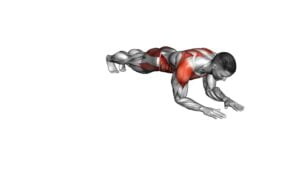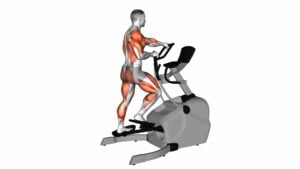Dumbbell Lateral Walk (male) – Video Exercise Guide & Tips

Looking to tone your muscles and improve your lateral strength? The dumbbell lateral walk is the perfect exercise for you!
Watch This Exercise Video
In this video exercise guide, we'll walk you through the proper form and technique, recommended dumbbell weight, variations and progressions, common mistakes to avoid, and tips for maximizing your results.
Get ready to level up your workout game and achieve your fitness goals with this effective exercise. Let's get started!
Key Takeaways
- Dumbbell Lateral Walk targets glutes, hips, and thighs, increasing stability and strength in lower body muscles.
- Proper form and technique involve maintaining an upright posture, engaging the core, and taking short and controlled lateral steps.
- Recommended dumbbell weight ranges from 5 to 15 pounds for beginners and up to 25 pounds for advanced individuals.
- To maximize results and avoid injury, gradually increase dumbbell weight, explore variations, and focus on mastering basic technique before adding resistance.
Benefits of Dumbbell Lateral Walk
You can experience increased stability and strength in your lower body muscles by incorporating the Dumbbell Lateral Walk into your exercise routine. This exercise targets the glutes, hips, and thighs, helping to improve overall lower body strength and stability. The Dumbbell Lateral Walk involves taking lateral steps while holding dumbbells, which adds resistance and intensifies the workout.
To modify the Dumbbell Lateral Walk, you can adjust the weight of the dumbbells according to your fitness level. If you're a beginner, start with lighter weights and gradually increase as you become more comfortable. Additionally, you can increase the intensity of the exercise by using resistance bands around your ankles or thighs.
There are also effective lateral walk variations that you can incorporate into your routine. One variation is the Dumbbell Lateral Squat Walk, where you perform a squat before taking each lateral step. This variation not only targets the lower body muscles but also engages the core and improves balance.
Another variation is the Dumbbell Lateral Lunge Walk, where you perform a lateral lunge before stepping to the side. This variation adds an extra challenge to your lower body muscles and increases the range of motion.
Proper Form and Technique
To perform the Dumbbell Lateral Walk with proper form and technique, start by standing with dumbbells at your sides. Keep your feet hip-width apart and maintain a slight bend in your knees throughout the exercise. Engage your core muscles and maintain an upright posture with your chest lifted.
As you begin the exercise, take a step to the side with your right foot, followed by your left foot. Keep your steps short and controlled, ensuring that your feet remain parallel to each other. Avoid crossing your feet or allowing your knees to cave inwards.
One common mistake to avoid is using too heavy of a dumbbell weight. It's important to choose a weight that allows you to maintain proper form and technique throughout the exercise. Using a weight that's too heavy can compromise your form and increase the risk of injury.
By focusing on maintaining good posture and using the correct weight, you can maximize the results of the Dumbbell Lateral Walk. This exercise targets the muscles of the lower body, particularly the glutes, hips, and thighs. It also engages the core muscles to stabilize the body as you move laterally.
Now that you understand the proper form and technique for the Dumbbell Lateral Walk, let's move on to the next section where we'll discuss the recommended dumbbell weight.
Recommended Dumbbell Weight
When it comes to the recommended dumbbell weight for the dumbbell lateral walk, there are a few key points to consider.
First, choose a weight that challenges you but allows you to maintain proper form throughout the exercise. It's important to start with a weight that you can comfortably handle and gradually increase the weight as you become stronger and more adapted to the exercise.
Optimal Weight Range
Discover the ideal weight range for dumbbells recommended for the Dumbbell Lateral Walk exercise.
The Dumbbell Lateral Walk is a lateral movement exercise that offers numerous benefits for your overall fitness. Lateral movements engage different muscle groups and help to improve balance, stability, and coordination. There are various types of lateral exercises, including lateral lunges, lateral raises, and lateral shuffles.
When it comes to selecting the right weight for the Dumbbell Lateral Walk, it's important to choose a weight that challenges you without compromising your form. The optimal weight range for this exercise typically falls between 5 to 15 pounds for beginners and up to 25 pounds for more advanced individuals.
Remember to start with a lighter weight and gradually increase as you become stronger and more comfortable with the movement.
Progression and Adaptation
To progress and adapt in the Dumbbell Lateral Walk exercise, you need to gradually increase the weight of the dumbbells. This will challenge your muscles and help you overcome plateaus.
The recommended dumbbell weight for this exercise depends on your fitness level and strength. As a beginner, start with lighter dumbbells, around 5 to 10 pounds. Once you feel comfortable and can perform the exercise with proper form, gradually increase the weight.
Aim for a weight that allows you to complete 10 to 12 reps with good technique, but still challenges you. As you continue to improve, you can further increase the weight to keep progressing and stimulating muscle growth.
Remember to always listen to your body and use proper adaptation techniques to avoid injury.
Variations and Progressions
Now let's explore some advanced progression options and variations for beginners for the dumbbell lateral walk exercise.
If you're looking to challenge yourself further, you can try increasing the weight of the dumbbells or adding resistance bands around your ankles.
For beginners, you can start by performing the exercise without any weights or using lighter dumbbells until you build up strength and stability.
Advanced Progression Options
Explore advanced variations and progressions for the Dumbbell Lateral Walk exercise to enhance your workout routine. Incorporating advanced modifications and techniques can take your lateral walk to the next level, challenging your muscles in new ways.
One advanced modification is to increase the weight of the dumbbells you use during the exercise. This will add more resistance and intensify the workout.
Another option is to perform the lateral walk on an unstable surface, such as a balance board or a foam pad. This will engage your core muscles even more as you try to maintain stability.
Additionally, you can incorporate resistance bands into the exercise by placing them around your ankles or knees. This will further target your glutes and hips, increasing the difficulty of the exercise.
Experiment with these advanced progressions to continually challenge your body and see greater results.
Variations for Beginners
Start with lighter dumbbells and focus on mastering the basic technique of the Dumbbell Lateral Walk exercise. As a beginner, it's important to start slowly and gradually increase the intensity of your workouts.
One modification you can try is to perform the exercise without any weights at all, focusing on proper form and control. This will help you build a solid foundation before adding additional resistance.
Another option is to use resistance bands instead of dumbbells. This can provide a different type of challenge and help you strengthen your muscles in a slightly different way.
Common Mistakes to Avoid
First, make sure to avoid these three common mistakes when performing the Dumbbell Lateral Walk exercise. By avoiding these mistakes, you can prevent injuries and improve stability during the exercise.
The first mistake to avoid is using too heavy of dumbbells. While it may be tempting to grab the heaviest weights available, using weights that are too heavy can put excessive strain on your muscles and joints. Start with lighter dumbbells and gradually increase the weight as you become more comfortable and confident with the exercise.
The second mistake is failing to maintain proper form. To perform the Dumbbell Lateral Walk correctly, keep your back straight, core engaged, and shoulders relaxed. Avoid rounding your shoulders or hunching over, as this can lead to poor posture and potential injuries. Focus on keeping your body in a straight line throughout the exercise.
Lastly, avoid taking too large of steps. When performing the Dumbbell Lateral Walk, take small, controlled steps to maintain balance and stability. Taking large steps can throw off your balance and increase the risk of tripping or falling.
Tips for Maximizing Results
To maximize your results with the Dumbbell Lateral Walk, focus on maintaining proper form and gradually increasing the weight as you become more comfortable and confident with the exercise.
Proper form is crucial for targeting the desired muscles and preventing injuries. Start by standing with your feet shoulder-width apart, holding a dumbbell in each hand at your sides. Take a step to the side with your right foot, followed by your left foot, maintaining a slight bend in your knees and keeping your back straight. Continue moving sideways for the desired number of steps, then reverse direction and repeat.
As you get stronger, consider incorporating resistance to maximize intensity. This can be done by using heavier dumbbells or by adding ankle weights. By gradually increasing the weight, you challenge your muscles and stimulate growth. However, be sure not to compromise your form or overdo it. It's important to find the right balance between pushing yourself and maintaining proper technique.
Remember to always listen to your body and adjust the weight accordingly. With consistent practice and gradual progression, you can maximize the effectiveness of the Dumbbell Lateral Walk and achieve your fitness goals.
Frequently Asked Questions
How Many Sets and Repetitions Should I Do for the Dumbbell Lateral Walk Exercise?
You should do multiple sets and repetitions for the dumbbell lateral walk exercise. The number of sets and repetitions will depend on your fitness level and goals.
The dumbbell lateral walk is a great exercise for targeting your glutes, hips, and thighs. It also helps to improve your balance and stability.
Can I Perform the Dumbbell Lateral Walk Exercise Without Weights?
Yes, you can perform the dumbbell lateral walk exercise without weights. It's always good to have alternative exercises if you don't have access to dumbbells.
By doing the lateral walk without weights, you can still benefit from the exercise. It helps in strengthening your glutes, hips, and thighs, while also improving your balance and stability.
Is the Dumbbell Lateral Walk Exercise Suitable for Beginners?
The dumbbell lateral walk exercise can be suitable for beginners. It helps to strengthen your leg muscles and improve your balance. If you're just starting out, you can modify the exercise by using lighter weights or even performing it without any weights at all. This allows you to focus on proper form and gradually increase the intensity as you get stronger.
The benefits of the dumbbell lateral walk for beginners include improved stability and increased lower body strength.
Can I Incorporate the Dumbbell Lateral Walk Exercise Into My Cardio Routine?
Incorporating the dumbbell lateral walk exercise into your cardio routine can provide several benefits.
This exercise helps to strengthen your glutes, hips, and thighs, while also improving your balance and stability.
To perform the dumbbell lateral walk properly for maximum results, start by standing with your feet shoulder-width apart, holding a dumbbell in each hand.
Take a step to the side and then bring your other foot to meet it.
Repeat this movement for a desired number of reps.
Are There Any Specific Muscles Targeted by the Dumbbell Lateral Walk Exercise?
When it comes to the dumbbell lateral walk exercise, there are specific muscles that are targeted. This exercise primarily works your glutes, hips, quads, and core muscles.
By incorporating the dumbbell lateral walk into your routine, you can reap several benefits. It helps improve your stability, balance, and overall lower body strength.
Additionally, it engages your muscles in a unique way, making it a great addition to your cardio routine for a well-rounded workout.
Conclusion
In conclusion, the dumbbell lateral walk is a beneficial exercise that targets the muscles of the lower body, particularly the glutes and hips. It can improve stability, balance, and strengthen the muscles involved in lateral movement.
By maintaining proper form and gradually increasing the dumbbell weight, individuals can progress and challenge themselves. Avoiding common mistakes and following the tips provided can help maximize results and ensure a safe and effective workout.

Author
Years ago, the spark of my life’s passion ignited in my mind the moment I stepped into the local gym for the first time. The inaugural bead of perspiration, the initial endeavor, the very first surge of endorphins, and a sense of pride that washed over me post-workout marked the beginning of my deep-seated interest in strength sports, fitness, and sports nutrition. This very curiosity blossomed rapidly into a profound fascination, propelling me to earn a Master’s degree in Physical Education from the Academy of Physical Education in Krakow, followed by a Sports Manager diploma from the Jagiellonian University. My journey of growth led me to gain more specialized qualifications, such as being a certified personal trainer with a focus on sports dietetics, a lifeguard, and an instructor for wellness and corrective gymnastics. Theoretical knowledge paired seamlessly with practical experience, reinforcing my belief that the transformation of individuals under my guidance was also a reflection of my personal growth. This belief holds true even today. Each day, I strive to push the boundaries and explore new realms. These realms gently elevate me to greater heights. The unique combination of passion for my field and the continuous quest for growth fuels my drive to break new ground.







